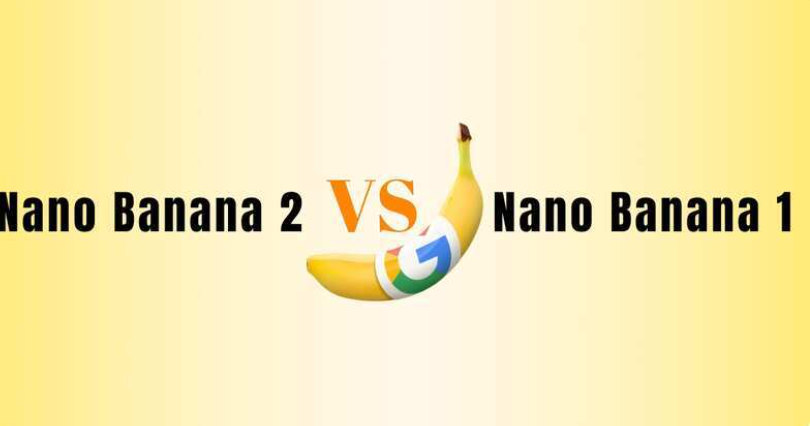Introduction: From Fast Diffusion to Intelligent Reasoning
Google's upcoming Nano Banana 2 represents a paradigm shift in AI image generation technology. While the original Nano Banana model impressed users with its speed and accessibility, the second generation promises to deliver something far more sophisticated: a reasoning-driven visual intelligence system that understands context, logic, and complex spatial relationships.
This comprehensive comparison explores the transformative upgrades between Nano Banana 1 (Gemini 2.5 Flash Image) and Nano Banana 2 (Gemini 3.0 Pro Brain), revealing how Google is redefining what's possible in AI-generated imagery.
Complete Feature Comparison Table
| Feature | Nano Banana 1 | Nano Banana 2 | Improvement |
|---|---|---|---|
| Architecture | Compact diffusion with lightweight text guidance | LLM “Brain” (Gemini 3.0 Pro) + High-fidelity diffusion “Hand” (GemPix 2) | Multi-stage reasoning loops |
| Resolution | Mid-range practical resolution | 4K native generation with 16-bit color | Professional-grade quality |
| Prompt Following | Good but required explicit detail | Advanced semantic understanding with validation loops | Strongest prompt-following ever |
| Text Rendering | Frequent hallucinations and spelling errors | Perfect text on screens, signs, and UI mockups | Near-Photoshop precision |
| Spatial Reasoning | Struggled with complex relations | Multi-step logic validation | Handles reflections, sequences |
| Visual Fidelity | Solid mid-tier quality | 4K upscale, improved surface physics, realistic materials | Cinema-quality outputs |
| Math & Diagrams | Unable to replicate precisely | Solves equations, recreates diagrams accurately | Technical documentation ready |
| Face Recognition | Stylized approximations | Highly accurate public figure likenesses | Photorealistic identity fidelity |
| Generation Speed | Fast iteration (speed-focused) | ~10 seconds per full-resolution image | Maintained efficiency |
| Consistency | Variable across batches | Stable multi-image consistency | Production-ready reliability |
| Interface Controls | Basic prompt input | Lightbox, camera sliders, reference flipping | Professional workflow tools |
| Color Rendering | Standard 8-bit with occasional banding | 16-bit color for smooth gradients | Film-grade color accuracy |
Architecture Revolution: The Brain-Hand Paradigm
Nano Banana 1: Speed-Optimized Diffusion
The original model utilized a straightforward compact diffusion mechanism designed for rapid generation. While effective for quick aesthetic drafts and stylized compositions, its architecture imposed fundamental limitations on logical consistency and complex scene understanding.
Nano Banana 2: Reasoning-First Generation
The revolutionary upgrade introduces a dual-component architecture that fundamentally changes how images are created. The Gemini 3.0 Pro “Brain” provides deep reasoning capabilities, analyzing prompts through multiple validation stages before the GemPix 2 “Hand” executes the visual generation. This shared latent intent vector fuses textual reasoning with pixel-level creation, enabling chain-of-thought processing similar to advanced language models.
This architectural leap transforms Nano Banana 2 from a pattern-matching diffusion model into a reasoning engine that happens to generate images.
Image Quality Upgrades: Professional-Grade Visual Fidelity
Resolution and Detail Enhancement
Nano Banana 2's jump to 4K native generation with optional reasoning-aware upscaling represents a quantum leap in output quality. The 16-bit color rendering eliminates the gradient banding that occasionally plagued the first version, while improved surface physics deliver realistic material behaviors including accurate reflections, subsurface scattering, and complex lighting interactions.
These enhancements position Nano Banana 2 as a viable tool for professional applications including product design, concept art, commercial imagery, and film pre-visualization workflows.
Text Rendering Breakthrough
One of the most significant practical improvements addresses text generation. While Nano Banana 1 frequently hallucinated letters and struggled with consistent spelling, Nano Banana 2 achieves near-perfect text rendering on screens, paper, signs, and UI mockups. The improved perspective alignment and shadow integration eliminate a major workflow bottleneck that previously required manual post-processing.
Semantic Understanding: From Pattern Matching to True Comprehension
Advanced Prompt Following
Nano Banana 2's most transformative upgrade lies in its prompt interpretation capabilities. The integration of Gemini 3.0's reasoning backbone enables multi-step validation loops and structural evaluation before final rendering. This allows the model to handle complex instructions that would confuse the first generation, including nested spatial relationships like “A reflection of X inside Y viewed through Z.”
Mathematical and Diagrammatic Precision
The ability to solve math equations presented in images, recreate diagrams without distortions, and handle tables, charts, and UI mockups opens entirely new application domains. Educational content creation, technical documentation, product design workflows, and corporate presentations can now leverage AI generation with confidence in structural accuracy.
Generation Performance and Workflow Integration
Despite the architectural complexity, Nano Banana 2 maintains practical generation speeds at approximately 10 seconds per full-resolution image. The enhanced multi-image consistency ensures production-ready reliability, while new interface features including Lightbox controls, camera sliders, and reference flipping tools accelerate prototyping and reduce iterative prompting.
Real-World Application Scenarios
Professional Design Workflows
The combination of 4K output, accurate text rendering, and reasoning-driven spatial understanding makes Nano Banana 2 suitable for client-facing creative work requiring pixel-perfect precision.
Technical Documentation
Mathematical accuracy and diagram fidelity enable automated generation of educational materials, engineering documentation, and scientific visualizations.
Marketing and E-Commerce
Perfect text rendering on product mockups, combined with realistic material physics, streamlines advertising asset creation and product photography replacement.
Film and Entertainment
Cinema-quality resolution, professional color grading capabilities, and consistent multi-image generation support pre-visualization and concept development pipelines.
Expected Release Timeline
Industry indicators point to a late November 2025 release window, with Gemini model deprecations scheduled for November 18 and enterprise bundling planned with Google One AI Premium subscriptions.
Conclusion: A New Category of Visual Intelligence
Nano Banana 2 represents far more than an incremental improvement over its predecessor. Where Nano Banana 1 excelled as a fast, accessible diffusion model for creative exploration, Nano Banana 2 introduces reasoning-driven visual intelligence that understands context, validates logic, and produces outputs with professional-grade precision.
The shift from “good diffusion with fast speed” to multimodal reasoning architecture creates a new paradigm for AI image generation. This isn't simply a version update—it's the beginning of a new class of visual models built on deep understanding rather than pattern matching.
For creators, designers, and technical professionals, Nano Banana 2 promises to eliminate the gap between AI-generated content and production-ready assets, making sophisticated visual creation accessible without sacrificing quality or control.
Ready to experience next-generation AI image generation? Explore Google's latest models including Nano Banana and Veo 3.1 video generation on Higgsfield's platform.









